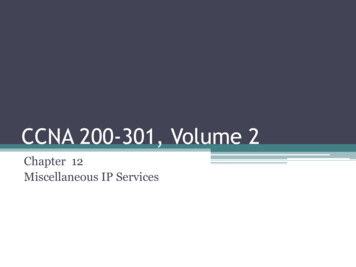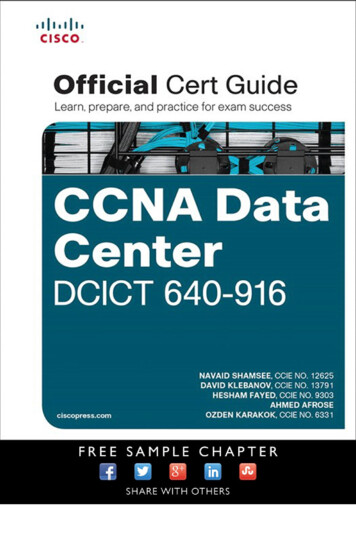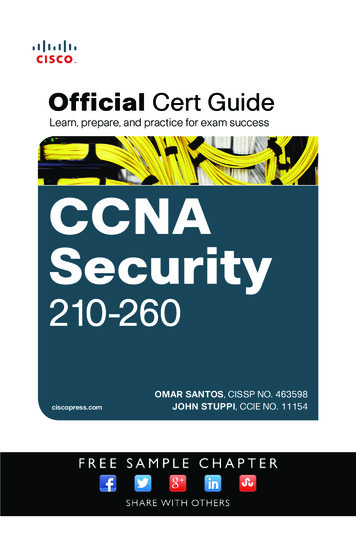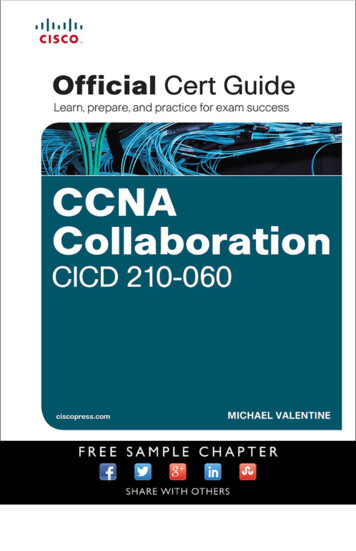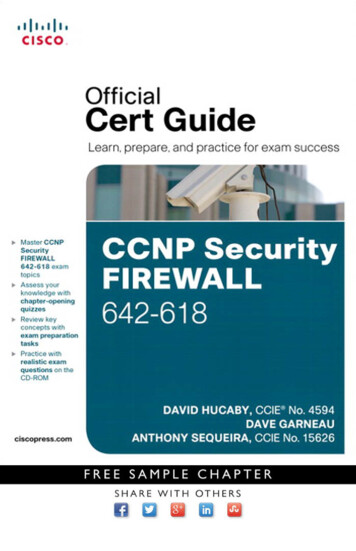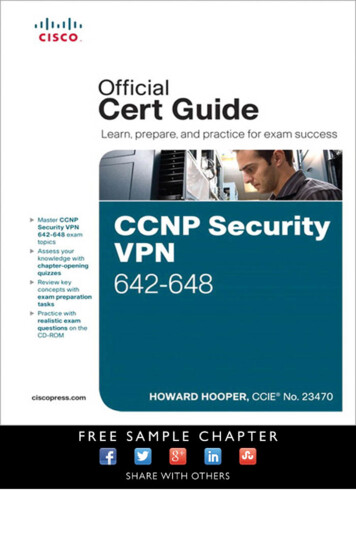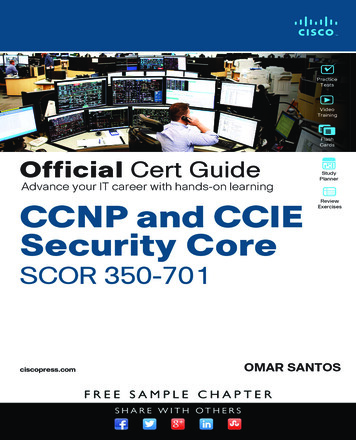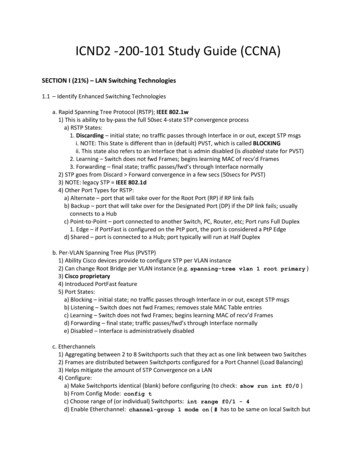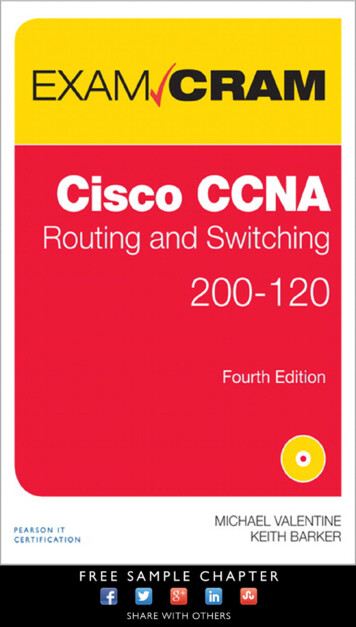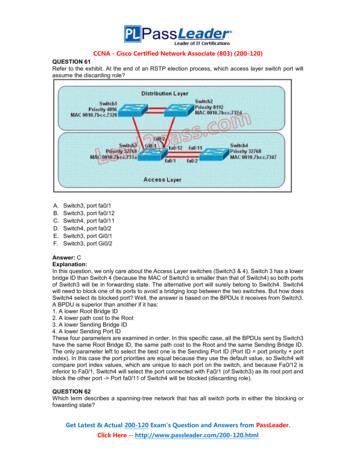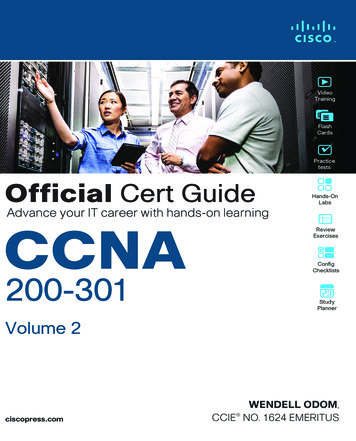
Transcription
CCNA 200-301, Volume 2Official Cert GuideIn addition to the wealth of updated content, this new edition includes a series of free hands-onexercises to help you master several real-world configuration activities. These exercises can beperformed on the CCNA 200-301 Network Simulator Lite, Volume 2 software included forfree on the companion website that accompanies this book. This software, which simulates theexperience of working on actual Cisco routers and switches, contains the following 13 free labexercises, covering ACL topics in Part I:1.ACL I2.ACL II3.ACL III4.ACL IV5.ACL V6.ACL VI7.ACL Analysis I8.Named ACL I9.Named ACL II10. Named ACL III11. Standard ACL Configuration Scenario12. Extended ACL I Configuration Scenario13. Extended ACL II Configuration ScenarioIf you are interested in exploring more hands-on labs and practice configuration and troubleshooting with more router and switch commands, go to www.pearsonitcertification.com/networksimulator for demos and to review the latest products for sale.CCNA 200-301 Network Simulator Lite, Volume 2 system requirements:Windows system requirements (minimum):Mac system requirements (minimum): W indows 10 (32/64-bit), Windows 8.1 (32/64-bit),or Windows 7 (32/64-bit) macOS 10.15, 10.14, 10.13, 10.12, or 10.11 1 gigahertz (GHz) or faster 32-bit (x86) or64-bit (x64) processor Intel core Duo 1.83 GHz 512 MB RAM (1 GB recommended) 1 GB RAM (32-bit) or 2 GB RAM (64-bit) 1.5 GB hard disk space 1 6 GB available hard disk space (32-bit) or20 GB (64-bit) 32-bit color depth at 1024 x 768 resolution D irectX 9 graphics device with WDDM 1.0 orhigher driver Adobe Acrobat Reader version 8 and above Adobe Acrobat Reader version 8 and above
CCNA200-301Official Cert Guide,Volume 2WENDELL ODOM, CCIE No. 1624 EmeritusCisco Press
iiCCNA 200-301 Official Cert Guide, Volume 2CCNA 200-301 Official Cert Guide,Volume 2Wendell OdomCopyright 2020 Pearson Education, Inc.Published by: Cisco PressAll rights reserved. No part of this book may be reproduced or transmitted in any form or by any means,electronic or mechanical, including photocopying, recording, or by any information storage and retrieval system, without written permission from the publisher, except for the inclusion of brief quotations in a review.ScoutAutomatedPrintCodeLibrary of Congress Control Number: 2019949625ISBN-13: 978-1-58714-713-5ISBN-10: 1-58714-713-0Warning and DisclaimerThis book is designed to provide information about the Cisco CCNA 200-301 exam. Every effort hasbeen made to make this book as complete and as accurate as possible, but no warranty or fitness isimplied.The information is provided on an “as is” basis. The authors, Cisco Press, and Cisco Systems, Inc. shallhave neither liability nor responsibility to any person or entity with respect to any loss or damages arisingfrom the information contained in this book or from the use of the discs or programs that may accompany it.The opinions expressed in this book belong to the author and are not necessarily those of Cisco Systems, Inc.Trademark AcknowledgmentsAll terms mentioned in this book that are known to be trademarks or service marks have been appropriatelycapitalized. Cisco Press or Cisco Systems, Inc., cannot attest to the accuracy of this information. Use of aterm in this book should not be regarded as affecting the validity of any trademark or service mark.Microsoft and/or its respective suppliers make no representations about the suitability of the informationcontained in the documents and related graphics published as part of the services for any purpose. All suchdocuments and related graphics are provided “as is” without warranty of any kind. Microsoft and/ or itsrespective suppliers hereby disclaim all warranties and conditions with regard to this information, includingall warranties and conditions of merchantability, whether express, implied or statutory, fitness for a particularpurpose, title and non-infringement. In no event shall Microsoft and/or its respective suppliers be liable forany special, indirect or consequential damages or any damages whatsoever resulting from loss of use, data orprofits, whether in an action of contract, negligence or other tortious action, arising out of or in connectionwith the use or performance of information available from the services.The documents and related graphics contained herein could include technical inaccuracies or typographical errors. Changes are periodically added to the information herein. Microsoft and/or its respective suppliers may make improvements and/or changes in the product(s) and/or the program(s) described hereinat any time. Partial screenshots may be viewed in full within the software version specified.Microsoft and Windows are registered trademarks of the Microsoft Corporation in the U.S.A. andother countries. Screenshots and icons reprinted with permission from the Microsoft Corporation. Thisbook is not sponsored or endorsed by or affiliated with the Microsoft Corporation.
iiiSpecial SalesFor information about buying this title in bulk quantities, or for special sales opportunities (which mayinclude electronic versions; custom cover designs; and content particular to your business, traininggoals, marketing focus, or branding interests), please contact our corporate sales department atcorpsales@pearsoned.com or (800) 382-3419.For government sales inquiries, please contact governmentsales@pearsoned.com.For questions about sales outside the U.S., please contact intlcs@pearson.com.Feedback InformationAt Cisco Press, our goal is to create in-depth technical books of the highest quality and value. Each bookis crafted with care and precision, undergoing rigorous development that involves the unique expertiseof members from the professional technical community.Readers’ feedback is a natural continuation of this process. If you have any comments regarding how wecould improve the quality of this book, or otherwise alter it to better suit your needs, you can contact usthrough email at feedback@ciscopress.com. Please make sure to include the book title and ISBN in yourmessage.We greatly appreciate your assistance.Editor-in-Chief: Mark TaubTechnical Editor: Elan BeerBusiness Operation Manager, Cisco Press: Ronald FliggeEditorial Assistant: Cindy TeetersDirector, ITP Product Management: Brett BartowCover Designer: Chuti PrasertsithManaging Editor: Sandra SchroederComposition: Tricia BronkellaDevelopment Editor: Christopher ClevelandIndexer: Ken JohnsonSenior Project Editor: Tonya SimpsonProofreader: Debbie WilliamsCopy Editor: Chuck Hutchinson
ivCCNA 200-301 Official Cert Guide, Volume 2About the AuthorWendell Odom, CCIE No. 1624 Emeritus, has been in the networking industry since1981. He has worked as a network engineer, consultant, systems engineer, instructor, andcourse developer; he currently works writing and creating certification study tools. Thisbook is his 29th edition of some product for Pearson, and he is the author of all editionsof the CCNA Cert Guides about Routing and Switching from Cisco Press. He has writtenbooks about topics from networking basics, certification guides throughout the yearsfor CCENT, CCNA R&S, CCNA DC, CCNP ROUTE, CCNP QoS, and CCIE R&S. Hemaintains study tools, links to his blogs, and other resources at www.certskills.com.
viiContents at a GlanceIntroductionxxviiPart IIP Access Control ListsChapter 1Introduction to TCP/IP Transport and ApplicationsChapter 2Basic IPv4 Access Control ListsChapter 3Advanced IPv4 Access Control ListsPart I Review3244464Part IISecurity ServicesChapter 4Security ArchitecturesChapter 5Securing Network DevicesChapter 6Implementing Switch Port SecurityChapter 7Implementing DHCPChapter 8DHCP Snooping and ARP InspectionPart II Review676886106122144168Part IIIIP ServicesChapter 9Device Management ProtocolsChapter 10Network Address TranslationChapter 11Quality of Service (QoS)Chapter 12Miscellaneous IP ServicesPart III Review171172202226254284Part IVNetwork ArchitectureChapter 13LAN ArchitectureChapter 14WAN ArchitectureChapter 15Cloud ArchitecturePart IV Review287288302328352Part VNetwork Automation355Chapter 16Introduction to Controller-Based NetworkingChapter 17Cisco Software-Defined Access (SDA)3823564
viiiCCNA 200-301 Official Cert Guide, Volume 2Chapter 18Understanding REST and JSON406Chapter 19Understanding Ansible, Puppet, and Chef428Part V Review 444Part VIFinal Review 447Chapter 20Final Review 448Part VIIAppendixes 467Appendix ANumeric Reference TablesAppendix BCCNA 200-301, Volume 2 Exam UpdatesAppendix CAnswers to the “Do I Know This Already?” Quizzes469476478Glossary 494Index530Online AppendixesAppendix DTopics from Previous EditionsAppendix EPractice for Chapter 2: Basic IPv4 Access Control ListsAppendix FPrevious Edition ICND1 Chapter 35: Managing IOS FilesAppendix GExam Topics Cross-Reference
xCCNA 200-301 Official Cert Guide, Volume 2Icons Used in This BookAccess PointPCLaptopServerIP PhoneRouterSwitchLayer 3 SwitchHubBridgeCable (Various)Serial LineVirtual CircuitEthernet WANSDN ControllerNetwork CloudvSwitchCable ModemIPSASAWirelessFirewallDSLAMCommand Syntax ConventionsThe conventions used to present command syntax in this book are the sameconventions used in the IOS Command Reference. The Command Referencedescribes these conventions as follows: Boldface indicates commands and keywords that are entered literally as shown.In actual configuration examples and output (not general command syntax),boldface indicates commands that are manually input by the user (such as a showcommand). Italic indicates arguments for which you supply actual values. Vertical bars ( ) separate alternative, mutually exclusive elements. Square brackets ([ ]) indicate an optional element. Braces ({ }) indicate a required choice. Braces within brackets ([{ }]) indicate a required choice within an optional element.
CHAPTER 5Securing Network DevicesThis chapter covers the following exam topics:1.0 Network Fundamentals1.1 Explain the Role of Network Components1.1.c Next-generation Firewalls and IPS4.0 IP Services4.8 Configure network devices for remote access using SSH5.0 Security Fundamentals5.3 Configure device access control using local passwordsAll devices in the network—endpoints, servers, and infrastructure devices like routers andswitches—include some methods for the devices to legitimately communicate using thenetwork. To protect those devices, the security plan will include a wide variety of tools andmitigation techniques, with the chapters in Part II of this book discussing a large variety ofthose tools and techniques.This chapter focuses on two particular security needs in an enterprise network. First, accessto the CLI of the network devices needs to be protected. The network engineering teamneeds to be able to access the devices remotely, so the devices need to allow remote SSH(and possibly Telnet) access. The first half of this chapter discusses how to configure passwords to keep them safe and how to filter login attempts at the devices themselves.The second half of the chapter turns to two different security functions most often implemented with purpose-built appliances: firewalls and IPSs. These devices together monitor traffic in transit to determine if the traffic is legitimate or if it might be part of someexploit. If considered to be part of an exploit, or if contrary to the rules defined by thedevices, they can discard the messages, stopping any attack before it gets started.“Do I Know This Already?” QuizTake the quiz (either here or use the PTP software) if you want to use the score to help youdecide how much time to spend on this chapter. The letter answers are listed at the bottomof the page following the quiz. Appendix C, found both at the end of the book as well ason the companion website, includes both the answers and explanations. You can also findboth answers and explanations in the PTP testing software.Table 5-1 “Do I Know This Already?” Foundation Topics Section-to-Question MappingFoundation Topics SectionQuestionsSecuring IOS Passwords1–4Firewalls and Intrusion Prevention Systems5, 6
88 CCNA 200-301 Official Cert Guide, Volume 25. A next-generation firewall sits at the edge of a company’s connection to the Internet.It has been configured to prevent Telnet clients residing in the Internet from accessingTelnet servers inside the company. Which of the following might a next-generationfirewall use that a traditional firewall would not?a.Match message destination well-known port 23b.Match message application datac.Match message IP protocol 23d.Match message source TCP ports greater than 491526. Which actions show a behavior typically supported by a Cisco next-generation IPS(NGIPS) beyond the capabilities of a traditional IPS? (Choose two answers)a.Gather and use host-based information for contextb.Comparisons between messages and a database of exploit signaturesc.Logging events for later review by the security teamd.Filter URIs using reputation scoresFoundation TopicsSecuring IOS PasswordsThe ultimate way to protect passwords in Cisco IOS devices is to not store passwords inIOS devices. That is, for any functions that can use an external authentication, authorization,and accounting (AAA) server, use it. However, it is common to store some passwords in arouter or switch configuration, and this first section of the chapter discusses some of theways to protect those passwords.As a brief review, Figure 5-1 summarizes some typical login security configuration on arouter or switch. On the lower left, you see Telnet support configured, with the use of apassword only (no username required). On the right, the configuration adds support forlogin with both username and password, supporting both Telnet and SSH users. The upperleft shows the one command required to define an enable password in a secure manner.Enableenable secret myenablepwTelnetEnable Mode(sw1#)SSH and TelnetUser Mode(sw1 )username
CCNA 200-301, Volume 2 Official Cert Guide In addition to the wealth of updated content, this new edition includes a series of free hands-on exercises to help you File Size: 2MBPage Count: 28

